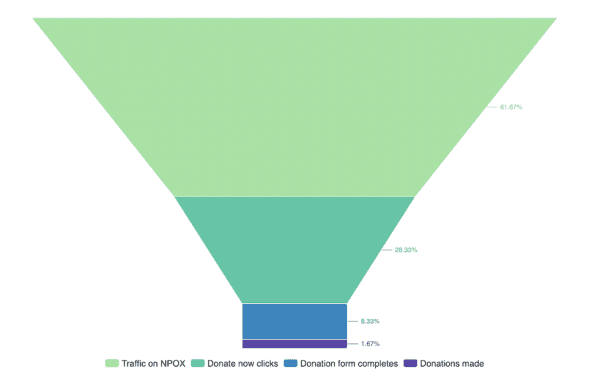One of the amazing things about a website is that it can give you valuable insight into the online behaviors of your site visitors, which in turn enables you to make smarter, more informed decisions when designing the user experience and content strategy of your site. In this article, we’ll cover the different metrics you should start tracking on your nonprofit’s website. If you’re still in the early stages of designing your site, be sure to check out our article about building a successful nonprofit website.
Below is the list of a few different metrics you can track on your website:
Traffic
This is a basic metric that simply tells you how many people have visited your website. Tracking the traffic on your site regularly helps you compare how your site performs in any given time period. For instance, if January saw 2000 visits to your site and February saw 1000 visits, you can begin to examine and identify the reason January performed better.
Average Session Duration
This is the average amount of time users are spending on your site. Depending on the amount of content and calls to action you have on your website, you can safely make an informed guess at how much time a user should be spending on your site. If users are bouncing off your site within seconds, this might indicate technical or serious user experience issues when they land on your pages. If your users are staying on, but not long enough to read your story or take any action on the site, this might be a sign that your content isn’t engaging enough to grab the user’s attention.
Bounce Rate
This is an indication of how many people leave your website without performing any action. A few reasons this could happen include technical difficulties, not enough content on your site to navigate further, content that’s not engaging enough or too dense and convoluted, or a user experience that isn’t effectively driving your users to where they need to be. There is no set benchmark for what this rate should be. However, it is advisable to track your bounce rate and continually work towards minimizing it.
New Visitors vs Returning Visitors
This is an interesting metric to understand how many new people you’re attracting to your website, and whether your content and marketing is motivating user’s to come back. If you’re promoting a new campaign or project over your marketing channels, this metric is a great way judge how well those promotions are performing, and whether they are effective with current supporters or newcomers.
Acquisition Source
This is another one that helps you track the impact of your marketing efforts. Tracking the source of acquisition means seeing exactly how a user got to your site. Was it from a campaign email you sent out? A link on a social media post? This will help you understand your best sources of conversion to further take budget allocation decisions.
Audience Demographics
Knowing where your visitors are coming from is an interesting metric to track for nonprofits that want to understand what demographics your messaging is attracting. When you can identify the types of people visiting your site and taking particular actions, you’re able to tailor your marketing efforts toward the demographic you want to attract.
Visitor Behavior
If your website has multiple pages that visitors can navigate to, visitor behavior metrics can help you track their navigation pattern on your site. This helps to analyze the flow of content on your website and finesse a user experience that takes visitors to the pages and sections you want them to see.
Online Conversion
If you’re a nonprofit that collects donations online, create a sales or donation funnel that helps you identify where users are falling off. Different user flows, design tweaks, and content changes can raise or lower the percentage of people who make it through the donation funnel.

All set to start tracking your website metrics? Depending on the platform your website is on, you can decide on the tool. Google Analytics is usually the most widely used tool for website analytics. That said, website builder platforms like Wix, Square Space, etc do have their own analytics too.




 These Social Media Planning Tools Streamline Your Nonprofit’s Marketing
These Social Media Planning Tools Streamline Your Nonprofit’s Marketing